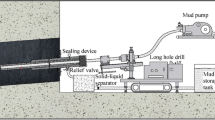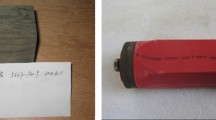Abstract
When drilling a CBM reservoir, the drill string moves up and down in the wellbore, causing fluctuations in the wellbore pressure. Wellbore pressure and pressure fluctuations deform the cracks and pores of coal, damaging the reservoir permeability. Therefore, the invasion of drilling fluid into coal under fluctuating wellbore pressure should be studied. We studied the effect of pressure, applied in various increments, on the permeability of coal, as well as the relationship between the coal’s permeability and the variation of fracture widths during pressure fluctuations. Drilling pressure and pressure fluctuations cause permanent damage to the coal’s permeability. The amount and the rate that different drilling fluids invaded into coal, under conditions of steady wellbore pressure and fluctuating wellbore pressure, were measured by studying core flow. When the wellbore pressure fluctuated, the invasion amount was greater. Large pressure differences and pressure fluctuations should be avoided during drilling for CBM reservoirs. Water invaded into the coal the most, and foam invaded into the least. These results provide technical guidance for planning and protecting a CBM reservoir, and help to improve CBM production.












Similar content being viewed by others
References
Cai YD, Liu DM, Pan ZJ et al (2015) Investigating the effects of seepage-pores and fractures on coal permeability by fractal analysis. Transp Porous Media 111:479–497
Chao JK, Yu MG, Chu TX, Han XF, Teng F, Li P(2019) Evolution of Broken Coal Permeability Under the Condition of Stress, Temperature, Moisture Content, and Pore Pressure. Rock Mechanics and Rock Engineering. https://doi.org/10.1007/s00603-019-01873-x
Chen D, Pan Z, Ye Z, Hou B, Wang D, Yuan L (2016) A unified permeability and effective stress relationship for porous and fractured reservoir rocks. J Nat Gas Sci Eng 29:401–412
Cui X, Bustin RM (2005) Volumetric strain associated with methane desorption and its impact on coalbed gas production from deep coal seams. AAPG Bull 89(9):1181–1202
Datta DR (2016) Coal, permeability. Encyclopedia Min Energy Pol. https://doi.org/10.1007/978-3-642-40871-7_101-1
Guo PK, Cheng YP, Jin K et al (2013) Impact of effective stress and matrix deformation on the coal fracture permeability. Transp Porous Media 103:99–115
He Y, Fu XH, Liu AH (2017) Experimental simulation on dynamic variation of the permeability of high-rank coal reservoirs. J Shanghai Jiao Tong Univ 22(6):726–732
Li XC, Kang YL, Luo PY (2009) The influence of stress on the crack width and permeability of coal. J Coalfield Geol Explor 37(1):29–32
Ouyang YL (2013)The damage of wellbore pressure and pressure fluctuation on the coal reservoir in the process of drilling. Graduate Dissertation, Yangtze University, Jingzhou, China
Palmer I (2009) Permeability changes in coal: analytical modeling. Int J Coal Geol 77(1):119–126
Pan Z, Connell LD, Camilleri M (2010) Laboratory characterisation of coal reservoir permeability for primary and enhanced coalbed methane recovery. Int J Coal Geol 82(3):252–261
Qi LS, Wang XW, Wang Y (2012) The study on the pressure fluctuation and reverse flow experiment in the process of drilling. J Tuha Oil Gas 17(3):297–300
Shi JQ, Durucan S (2013) Exponential growth in San Juan Basin Fruitland coalbed permeability with reservoir drawdown? Model match and new insights. SPE Reserv Eval Eng 13(6):914–925
Sun XX, Yao YB, Nino R et al (2017) A Novel Method for Gas–Water Relative Permeability Measurement of Coal Using NMR Relaxation. Transp Porous Media 124:73–90
Wang CL, Zhang XD (2018) Distribution rule of the in situ stress state and its influence on the permeability of a coal reservoir in the southern Qinshui Basin, China. Arab J Geosci 11:586
Wu CF, Qin Y, Zhou LG (2013) Effective migration system of coalbed methane reservoirs in the southern Qinshui Basin. Sci China Earth Sci 57(12):2978–2984
Yang TH, Xu T, Liu HY, Tang CA, Shi BM, Yu QX (2011) Stress–damage–flow coupling model and its application to pressure relief coal bed methane in deep coal seam. Int J Coal Geol 6(4):357–366
Yang J, Wang JG, Wang HJ et al (2016) CO2 permeability of fractured coal subject to confining pressures and elevated temperature: experiments and modeling. Science China Technol Sci 59(12):1931–1942
Zhang C, Zhang L (2018) Permeability Characteristics of Broken Coal and Rock Under Cyclic Loading and Unloading.Natural Resources Research. https://doi.org/10.1007/s11053-018-9436-x
Zhang C, Tu S, Bai Q, Yang G, Zhang L (2015) Evaluating pressure relief mining performances based on surface gas venthole extraction data in longwall coal mines. J Nat Gas Sci Eng 24:431–440
Zhang C, Zhang L, Wang W (2018) The axial and radial permeability testing of coal under cyclic loading and unloading. Arab J Geosci 12:371
Zhang ZT, Zhang R, Wu SY et al (2019) The stress sensitivity and porosity sensitivity of coal permeability at different depths: a case study in the Pingdingshan mining area. Rock Mech Rock Eng 52:1539–1563
Zhou YB, Li ZH, Yang YL, Zhang L, Si L, Kong B, Li J (2016) Evolution of coal permeability with cleat deformation and variable Klinkenberg effect. Transp Porous Media 115:153–167
Funding
This research was funded by National Natural Science Foundation of China, grant number 51804043, and it was also funded by Yangtze fund for youth teams of science and technology innovation, grant number 2016cqt03.
Author information
Authors and Affiliations
Contributions
S.Z. was in charge of project administration, experiment design and writing-review manuscript. Y.L. and Y.P. were in charge of investigation, experiment validation and writing original manuscript. T.L. and D. D were in charge of data curation and formal analysis.
Corresponding author
Ethics declarations
Conflict of interest
Declare conflicts of interest or state “The authors declare no conflict of interest.” Authors must identify and declare any personal circumstances or interest that may be perceived as inappropriately influencing the representation or interpretation of reported research results. Any role of the funders in the design of the study; in the collection, analyses or interpretation of data; in the writing of the manuscript, or in the decision to publish the results must be declared in this section. If there is no role, please state “The funders had no role in the design of the study; in the collection, analyses, or interpretation of data; in the writing of the manuscript, or in the decision to publish the results”.
Additional information
Responsible Editor: Santanu Banerjee
Rights and permissions
About this article
Cite this article
Zheng, S., Liu, Y., Pan, Y. et al. The invasion of drilling fluid into coal under fluctuating wellbore pressure. Arab J Geosci 13, 334 (2020). https://doi.org/10.1007/s12517-020-05341-7
Received:
Accepted:
Published:
DOI: https://doi.org/10.1007/s12517-020-05341-7




